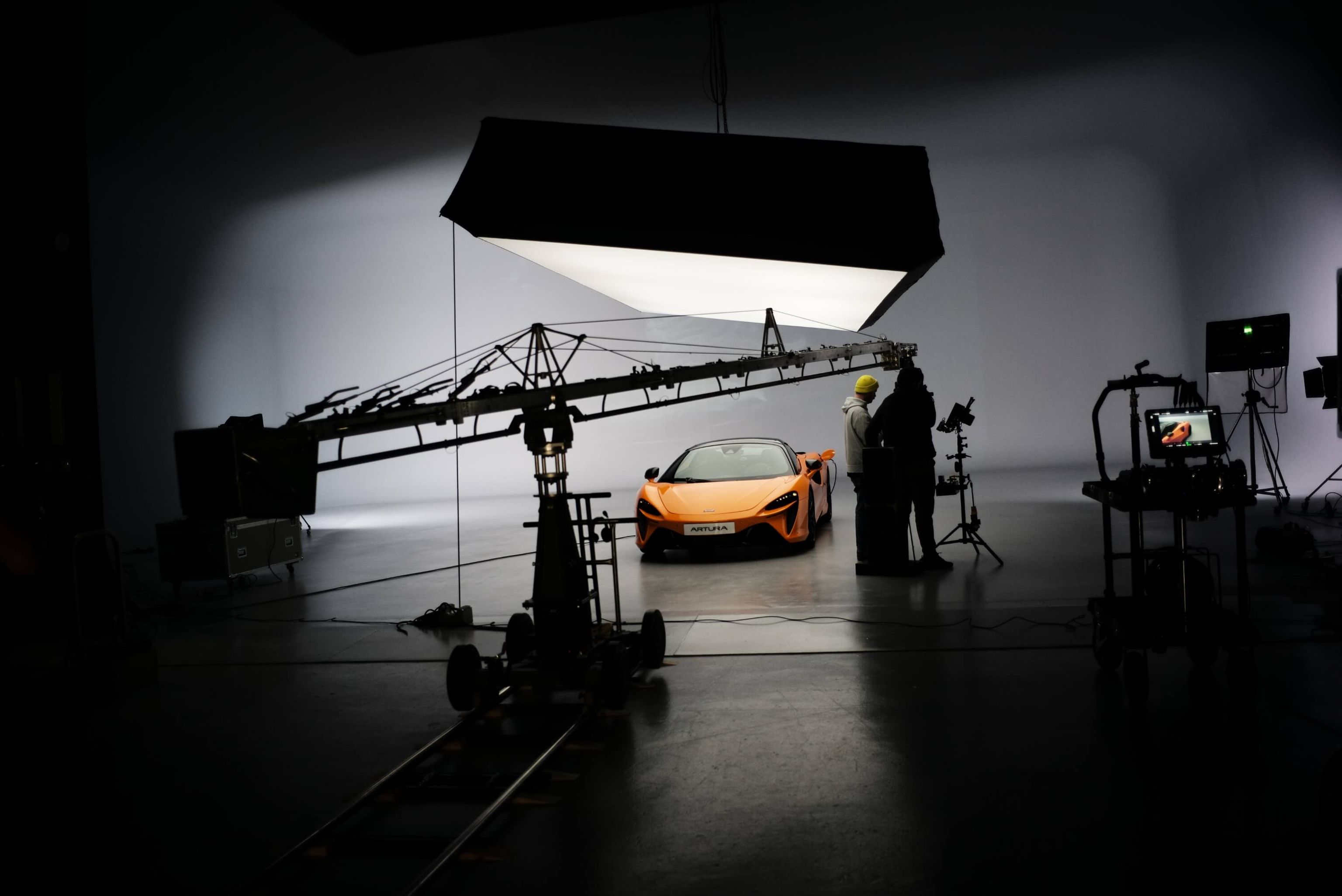Gramafilm recently hosted a roundtable for luxury automotive leaders to discuss changing marketing expectations amidst the push for lower emissions. Participants from McLaren, Tesla, Jaguar Land Rover, Turo, and others agreed: electrification isn't just a shift – it's a complete departure from the past. That makes this a big opportunity to present brands differently, but also a big challenge for marketers who are steeped in tradition. Let's delve into these below.
Automotive advertising is, after all, a cultural institution. Few industries have enjoyed such a well-established creative language to draw upon, such a level of clarity around its audience, or such a central role in the history of brand-building.
And in that story, the luxury automotive sector punches significantly above its weight.
Thirteen of the top hundred most valuable brands, according to Interbrand’s latest ranking, are carmakers. Volkswagen, one of the world’s two largest automotive manufacturers, places slightly lower than its own subsidiary Porsche. Ferrari makes the list on the back of producing just tens of thousands of vehicles – while Fiat, its mass-market Italian peer, doesn’t rank at all.
13%
Of top value brands are car brands.
The industry’s quality of being driven by brand identity, in other words, finds its purest expression in its luxury aspects.
However, as carmaking undergoes a near-total transformation, many ideas and strategies no longer hold the currency they once did. In a rapidly electrifying, increasingly digital world, old assumptions about how to sell cars are becoming increasingly less certain.
The result, according to one roundtable attendee, is that this is a unique moment of brand agnosticism for the industry.

Buying an EV is not just another car purchase, but a step into a whole new product category.
Buying an EV is not just another car purchase, but a step into a whole new product category.
Or, as another put it, automotive brand marketing today feels ‘chaotic’.
But in that chaos, they were quick to add, lies opportunity. It is not entirely inaccurate to joke, as one attendee did, that creative content used to be able to focus on filming the car going sideways and ‘vroom’ – and the loss of that (due to the changing consumer reality as much as the quietness of EV powertrains) could be felt as a threat.
Knowing that every brand shares that challenge, though, also makes this a chance to put forward new brand strategies that capture new market segments. The cutting edge of the industry is already seizing this opportunity: reintroducing brands through a new language and set of audience insights, offering new benefits, lifestyles, and ways of interacting with mobility, will prove to be a creative moment for the industry unlike any other.
2035
UK deadline for all new cars to be electric vehicles (EVs)
-
New niches, new insights
At the roundtable, examples were raised of how manufacturers have started to ‘re-niche’ their offerings to the market. In some cases, they are starting from scratch to meet the audience anew. Volvo’s Polestar, for example, was highlighted for its seamless approach to crafting a fresh, carefully targeted identity which reflects its owner’s heritage without relying on it.
Others are becoming notably experimental, subverting market expectations about their brands’ value. BMW’s recent creative work, for example, was labelled as ‘weird’ – work which has clearly been designed to capture the deep attention of a new, specific target audience.

On a broader level, these examples show how realising the opportunity that lies in chaos starts with new audience insights.
On a broader level, these examples show how realising the opportunity that lies in chaos starts with new audience insights.
The audience for supercars, for instance, has less intrinsic interest in purely electric vehicles. For them, an engine is not just a well-honed tool – it is art. Lacking the mechanical poetry that purchasers desire, EVs have a steep hill to climb in this context.
As one attendee had it, a Casio may do everything a Rolex does, but it’s the engineering that sets it apart.
Higher ticket price for electrified options demands a carefully crafted perception of luxury
– Branding EV’s in the Electric Age, Gramafilm
For higher-volume brands that trade on practicality as well as exclusivity, the higher ticket price for electrified options demands a carefully crafted perception of luxury. One attendee said that relying on environmental benefits alone would be a mistake, given that higher costs need to be ultimately justified with consumer value.
That might be the key quality of the examples of brands doing it well which attendees identified: it’s not just the vehicle you already love, made electric. It’s something believably different, which speaks to its audience in its own way.
180%
Surge in entry-level Jaguar cost with EV models
-
Pitching the future
Of course, selling an electric car is not a new challenge: many questions in this space have already been answered, and in the UK nearly one-in-six new car registrations are now battery electric vehicles.
However, there was a general agreement among attendees at the roundtable that those sales have been driven by a minority early adopter segment of the market for whom an electric powertrain is in itself enough of purchasing decision-maker. Whether motivated by the environment or the technology, this is an audience which will accept risks in order to adopt a new product category.

But as one attendee said, that audience is ‘over’. The early adopters have adopted. Now, the focus is on the rest.
But as one attendee said, that audience is ‘over’. The early adopters have adopted. Now, the focus is on the rest.
This lies at the heart of a need to shift how automotive brands approach creative work, and soon. As one attendee summed it up, the difficulty right now is that, while most consumers buy with their hearts, EV pitches still target their heads.
Technical vehicle details, for instance, often rise to the surface in this content, and not without reason. Battery range, charging speed, and EV infrastructure are focused on in order to head off potential concerns about quickly-evolving electric vehicle technology.
While most consumers buy with their hearts, EV pitches still target their heads.
– Reinventing the Wheel, Gramafilm
But until now people have been able to make assumptions about things like the availability of fuel and the availability of mechanics to provide effective servicing. For many, a likely response to spotlighting such technical aspects will be to ask, worried, ‘but is it ready?’.
Instead, brands need to generate a real sense of emotive belief – beyond the good rational reasons for technological change – in order to grow this market.
For one attendee, this shift in requirements is dramatic enough that the ‘eco pitch is dead’. Going forward, green credentials might be at most a secondary message, and a new approach needs to come to the fore.
The eco pitch is dead.
– Partner, Deloitte
A big part of that will be to offer original, feelings-led, consumer-centric visions of the modern driving experience.
-
A new road to the wheel
Today, new vehicle models are being designed with digital integration from the ground up.
This has two main consequences for how people interact with them.
- First, it makes cars, for the first time, part of people’s digital ecosystems. As with the realities of charging and vehicle range, things like app-based management and over-the-air software updates need to build an assumption of trust, and so that experience needs to work on a branding and emotional level as well as a technical one.
- The second, perhaps more dramatic consequence will be in how people access and use vehicles in the first place. Here, smarter vehicles which can digitally report their status in real time, unlock or perhaps even self-drive are opening up new possibilities.
Subscriptions to access luxury mobility on an as-need basis, long-term rentals which can be swapped for different vehicles as necessary, and peer-to-peer sharing economy apps for cars are just some of the business models which are early-stage, but viable and rapidly evolving.
These developments can amortise the cost of high-end mobility, lowering the barrier of access to luxury brands and taking friction out of EV adoption. Of course, that also catalyses this moment as one of slipperiness in brand loyalty, as consumers become more able to move between brands more often.
75%
Of potential EV buyers plan to spend under $50,000
In terms of brand equity, that’s a significant shift. The value of luxury branding, of course, is never wholly embedded in the brand’s ownership base; Ferrari’s position as the 70th most valuable brand in the world is due to a recognition much wider than the few who own their vehicles. But if the realities of exclusivity change, mobility itself will need to be made a luxury proposition, as opposed to aligning it entirely with the physical product at hand.
Lowering the barrier of access to luxury brands and taking friction out of EV adoption.
– Reinventing the Wheel, Gramafilm
And any such evolution in how automakers go to market needs to be closely tied to the value built around the product and the experience it offers – and that calls for an innovative creative approach.
-
Evolving content expectations
Any discussion about marketing the new automotive age must account for a significant outlier. In the sixteen years since the delivery of the first Roadster, Tesla has become a huge force in the industry, spending a long period as the largest manufacturer of EVs by volume and still holding its position as the most valuable automaker by market cap.
And all of that – as has often been noted – without engaging in traditional marketing, advertising, or PR.
In itself, this might be taken as evidence for how dramatically automotive marketing is changing. Certainly, there is a degree of industry envy about how Tesla hasn’t had to ‘re-niche’, having been purely electric from day one. For our roundtable attendees, though, the lesson was far from one of pulling away from traditional approaches.
For one thing, Tesla itself is now testing and learning how to build content campaigns which complement the brand’s unique market position.

Like its competitors, it is seeking to tell a new mobility story through the lens of the customer’s experience, not the technology.
Like its competitors, it is seeking to tell a new mobility story through the lens of the customer’s experience, not the technology.
More fundamental, though, is the fact that (for all its renown) Tesla is much smaller than the overall market it plays in – and the competition to win those wider audiences will lead to a wide variety of messages and strategies being deployed.
Attendees suggested that whatever those stories are, their best creative is likely to be long-form.
It is difficult, after all, to sell a whole new lifestyle through the medium of a three second clip.
– Reinventing the Wheel, Gramafilm
Our cultural moment, too, shows an appetite for work that demands deeper engagement, with long reads, slow television, and marathon YouTube videos a constant cultural presence alongside the instant gratification of video social media. This is a context that feels ripe for work of the scope that bringing people into a new product category, or even a whole new lifestyle, demands.
Finally, there was a palpable feeling of excitement and possibility around the future of creative automotive content.
To be able to draw on an established framework of effective visuals and sounds – the car going sideways, the engine going ‘vroom’ – is a fortunate position to be in. But those days are over, and ultimately what’s more exciting is to invent brand new imagery that will reflect and accelerate an industry in deep transformation.
EV Content Production, Gramafilm
Gramafilm is a B Corp™ certified, award-winning creative production agency united by a passion for storytelling.
Based in London since 2008, we've spent the last 16 years collaborating with international clients across culture, automotive, technology and healthcare, creating strategic branded content for global audiences.
Captivating films. Engaging socials. Impactful design. We lean on our years of experience to find those authentic points of connection which make for more compelling, human stories. (Clients include Red Bull, Google, AlphaTauri, McLaren, Amazon, Jeep, YouTube, Bafta, Android, Google DeepMind and many more.)
Ready to discuss your content strategy? Schedule a free consultation with our founder, James Morton-Haworth.
More 








